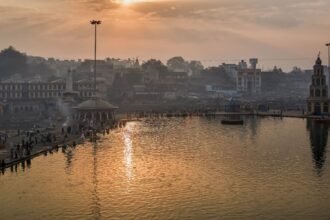The grandeur of Amrit Kalash Kumbh Mela 2027 in Nashik is not just built on faith—it is deeply intertwined with ancient mythology and cosmic symbolism. At its heart lies the legendary tale of the Amrit Kalash, the celestial pot of nectar that spilled divine drops on Earth, giving birth to the holiest Hindu pilgrimage.
As millions gather in Nashik for the upcoming Kumbh Mela, they do so in honour of this myth, re-enacting a timeless moment when the heavens and Earth converged.
The Cosmic Churn: Samudra Manthan and the Birth of the Nectar
The story begins with the Samudra Manthan, or the Churning of the Ocean of Milk—one of the most pivotal events in Hindu scriptures. In this cosmic episode, the Devas (gods) and Asuras (demons) teamed up to churn the ocean in search of Amrit, the nectar of immortality.
They used:
- Mount Mandara as the churning rod
- Vasuki, the great serpent, as the rope
From the ocean emerged fourteen celestial treasures, the most significant being the Amrit Kalash—a pot holding the elixir of eternal life.
Also read : The Deeper Meaning of Kumbh Mela Fasting Before the Holy Dip in Nashik 2027
A Divine Struggle for the Nectar
The moment the Amrit appeared, chaos followed. Both Devas and Asuras wanted to claim it. To protect it, Lord Vishnu took the form of Mohini, a divine enchantress who distracted the demons and safeguarded the Kalash.
As Mohini moved swiftly across the heavens with the pot, four drops of nectar fell to Earth—sanctifying:
- Prayagraj (Allahabad)
- Haridwar
- Ujjain
- Nashik
These four locations became eternally sacred, chosen to host the Kumbh Mela in a 12-year rotational cycle, in sync with planetary alignments that recreate that cosmic moment.
The Significance of Nashik in the Myth
In Nashik, it is believed that one drop of Amrit fell into the Godavari River, transforming it into a divine stream capable of purifying karma and elevating the soul.
Especially sacred is Trimbakeshwar, near Nashik, where mythology places the celestial spill. This region has since become a revered pilgrimage centre, and during Kumbh Mela 2027, millions will flock here to reconnect with this mythic event.
Symbolism of the Amrit Kalash for Pilgrims
The Amrit Kalash is more than a mythological pot—it carries profound symbolism:
- The Kalash represents the human body as a container of divine potential
- The Amrit is the soul’s eternal truth, untouched by time
- The churning symbolises life’s struggles and karmic evolution
- The holy dip is the soul’s return to purity and divine connection
Every act at Kumbh Mela is a reenactment of this journey—from chaos to clarity, from mortality to spiritual liberation.
Kumbh Mela Timing: Echoes of Celestial Events
The occurrence of Kumbh Mela is never arbitrary. It is determined by astrological alignments, particularly:
- Jupiter’s entry into Leo (Simha Rashi) or Aquarius (Kumbh Rashi)
- The Sun’s transition into Aries or Capricorn
- Lunar conjunctions that reflect the cosmic energies of the original Amrit spill
These rare alignments recreate the spiritual vibration of that mythic moment, making the Kumbh a doorway to the divine.
Rituals That Retell the Myth
Rituals at the Kumbh are rich in symbolism, designed to mirror the Amrit Kalash legend:
- Shahi Snan processions represent the Devas arriving to claim the nectar
- Holy dips in the Godavari symbolise internalising divine truth
- Kalash Sthapana (pot installation) rituals invoke celestial grace
- Lighting of diyas and chanting of Vedic mantras renew the energy of the original event
Every step—from bathing to prayer—carries echoes of this cosmic tale.
Final Thoughts
The legend of the Amrit Kalash is not just an ancient story—it’s the spiritual heartbeat of Kumbh Mela 2027. It teaches that true immortality lies in awakening, not escape; in truth, not possession.
By taking the holy dip in the Godavari at Nashik, pilgrims aren’t just following a ritual—they’re retracing the celestial footsteps of gods, reliving the myth, and receiving a symbolic taste of the divine nectar.
So, when you walk to the river in Nashik in 2027, remember: you’re not just stepping into sacred waters. You are entering a living myth, where the Amrit Kalash continues to pour blessings—for those ready to receive.





